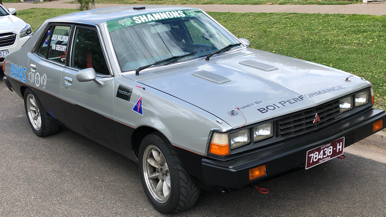PAVAS-
Progressive Audible Vehicle Alarm Speed

PAVAS
is designed to improve car rallying performance. It does this by
helping the competitors manage their speed by using a variety of
audio tones, via an internal helmet mounted speaker. Audio tones
allow the driver to maintain visual focus on the driving task by
applying the under utilized sense of hearing. It is particularly
applicable in tarmac rallies.

Does
it work? Do you want to win?
Here
are some results!
What
does it sound like?
Here
are videos showing PAVAS
operation and the guidance tones
Here
is a Flyer as A PDF summarizing the PAVAS features
Speed
Limited Rally Events
Many rally
events are determined by the time to complete an event. However,
given the power and ultimate speed of modern vehicles, many events
have adopted a maximum speed limit . The trade off is, that the event
tests the skill of the driver and navigator was well as reliability
and performance of the vehicle. The advantage to the competitors is
that they can enter a vehicle of modest performance and cost but yet,
still be competitive against more powerful machines. This also
reduces the required resources and effort and opens events up to a
larger number of potential competitors.
PAVAS Key
Points
Multiple
modes for Speed Monitoring, TSD, Targa Florio and Reliability
Events.
Indicates
proximity to alarm conditions
Unique
speed guidance techniques
Simple
controls and configuration
Operation
with multiple remote joysticks
Accurate
speed and distance measurements.
Fast
parameter updates.
Auxiliary
visual guidance for the navigator.
Rotating
message displays with manual override.
Integrated
operator help messages.
Multiple
calibration techniques.
Launch
and default start up modes.
Easy
fitting to any vehicle.
Magnetic
distance probe for harsh conditions.
Automatic
TSD stage and Reliability lap results log.
Targa
Florio Stages.
Data
Logging.
PAVAS
Advantages and Benefits
The other
significant point is that the events can be executed at lower speed
which dramatically increase the chance of survival in the case of an
accident. This can be simply demonstrated by considering the physics
of a moving vehicle. The kinetic energy of an object proportional to
its mass and the square of the velocity. Given that the mass remains
constant, if the speed it doubled, then the kinetic energy is four
times greater. The worst case to consider is, if the object is
brought to a complete stop; then that kinetic energy is dissipated by
doing work which in this case would be deforming the vehicle and the
occupants. So, it is simple to see, how vehicle speed severely
affects vehicles and occupants, in the case of an accident.
Event timing
becomes crucial to producing the best performance in speed limited
events. There are a number of systems on the market to aid drivers
and navigators to compete in a rally event. However most of the
feedback is visual and hence is directed at the navigator who then
has to inform the driver of the situation. There are many
disadvantages to this approach; firstly it distracts the driver's
concentration from accessing the vehicle's current situation related
to speed and position on the road. Secondly, there is a
communications delay, while the navigator accesses, interprets and
conveys the information to the driver. This may seem trivial but
given that time is crucial in these events, any communications delay
is costly, in terms of event performance. In addition, it distracts
the navigator from the prime mission of tracking the vehicle's
location.
Some systems
use an audible beep to indicate just one speed alarm. Though
beneficial, they don't allow a driver to continuously manage his
speed.
The prime role
of the navigator is describe upcoming road conditions as well as to
monitor the speed. PAVAS reduces this burden by audibly providing
speed information by a separate speaker system. This allows the
driver to instantly access his speed and adjust it, so that he is
within the limits and on target to complete the events in the
required time. His eye focus and direction are not impacted and so he
can economically execute his mission which is to drive.
The audible
signal used in PAVAS is complex and filled with cues to indicate
performance and speed limits. PAVAS has multiple operating modes and
can be utilized in many types of timed and speed limited events. All
the event parameters can be stored before hand and the event data is
simply recalled at the start of a stage. PAVAS is also beneficial
when operating on transport stages and reduces the possibility of
traffic fines, event penalties or exclusion. PAVAS can automatically
start at a predetermined menu, saving keystrokes and setup time.
PAVAS is
designed with a emphasis to simplify the operations and foster quick
learning by making all menus consistent and similar. PAVAS contains
demonstration modes for training, familiarization, troubleshooting
and testing scenarios. PAVAS contains configuration, calibration and
systems menus to compliment the tasks. PAVAS does not use GPS
measurements which are subject displacement errors but uses direct
wheel rotation distance.
PAVAS's main
mission is to use audible tones to guide the driver.
This web site
provides information on PAVAS operations. The PAVAS
Menus shows all the menus used in order of frequency. There is a
map of the web site that shows the
controls, how to edit values, sound generation, troubleshooting,
results and videos.
Software
sections licensed to JMP CLR, Inc.
2022-03-02

